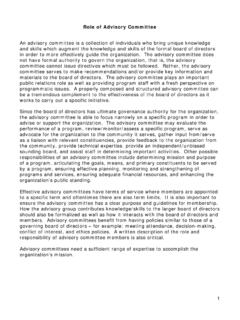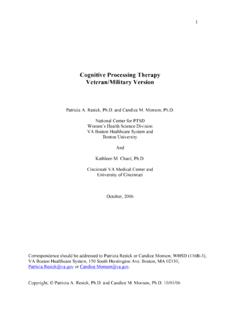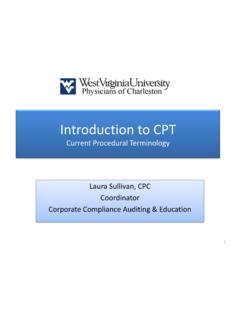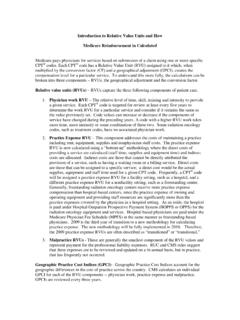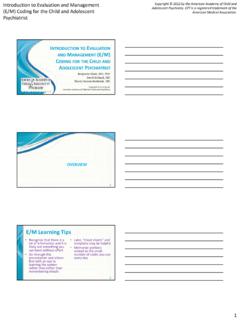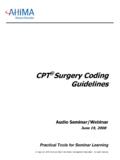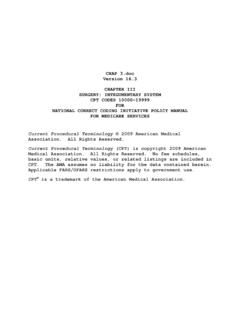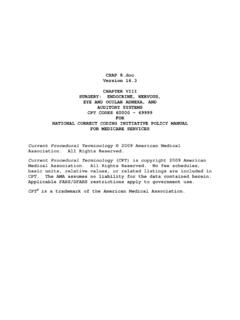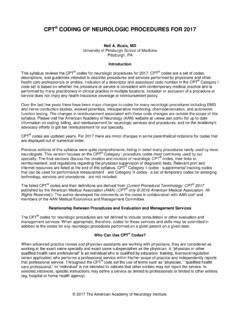Transcription of INTRODUCTION TO CPT CODING - CHAMPS Online
1 Thank you for attending INTRODUCTION TO CPT CODING A CHAMPS webcast presented by Maureen Hong, PA, FNP, MHA on Tuesday, May 10th, 2005 SUPPLEMENTARY INFORMATION PACKET I. CODING for Profitability Pages 2-4 II. CODING Systems Page 5 III. Evaluation and Management Service Codes Pages 6-7 IV. General Information about Page 8 IV. Presentation Slide Text Pages 9-10 IV. Biography of Maureen Hong Page 11 INTRODUCTION to CPT CODING Webcast, May 10, 2005 2 Presented by Maureen Hong; Sponsored by Community Health Association of Mountain/Plains States CODING FOR PROFITABILITY, OR, "HOW TO SPEAK THEIR LANGUAGE" Whenever one is presented with the task of learning a foreign language, two issues immediately come to mind: vocabulary and rules of grammar. Learning to use the CPT CODING system is, in effect, learning to speak a foreign language. Therefore, you must learn the vocabulary and the rules of grammar. RULES OF GRAMMAR The rules of grammar are sometimes dependent upon the region of a country (field of medicine) you are visiting.
2 This is due to the use of idiomatic language (different ground rules). The rules of grammar, for the language we will call CPT, are contained in several sections of the CPT language book: forward, INTRODUCTION , and guidelines. Each section of the country (book) has its own rules of grammar. In our language manual (CPT) these are divided into Evaluation & Management (E&M), Medicine, Surgery, Anesthesia, Radiological Services, and Pathological Services. Everything contained in the forward and INTRODUCTION applies to all areas of the country. Each area, however, contains its own idioms (ground rules for use of codes), and these must be familiar to the traveler, if the traveler hopes to make his/her needs known to the natives. Consequently, if not familiar with the content of the forward, INTRODUCTION , and rules of grammar of the area you will be visiting (ground rules), you will not speak the language with any degree of proficiency. Frequently, you will be conversing with individuals whom you believe to have expert knowledge of the language (clerks for insurance companies), but who, in fact, do not.
3 When faced with this situation, you must be fluent in the language in order to aid them in understanding you, and to know (based on reimbursement levels) when they have misunderstood, or misinterpreted, what you have said. PHRASING You have probably had the opportunity to listen to people who use certain phrases with such frequency that you finally begin to "tune them out". When you are speaking CPT, you must be very careful of the way you phrase what it is you want to say. If you overuse or abuse the vocabulary (codes) that is/are available to you, those who are conversant in the language will soon begin to "tune you out" (reimburse at a lesser level). OVERUSED AND ABUSED PHRASES (CODES) There are certain codes that, when overused, can cause you a great deal of harm by way of altering your Fee Profile (or causing you problems with CMS or the OIG), and therefore, resulting in consistently lower reimbursement. Conduct an audit to determine which codes in your clinic are overused.
4 The overuse and abuse of codes indicates that you are not taking the time to code properly, and frequently results in your being reimbursed at a lower level than deserved. Overuse and abuse of INTRODUCTION to CPT CODING Webcast, May 10, 2005 3 Presented by Maureen Hong; Sponsored by Community Health Association of Mountain/Plains States codes can raise "red flags" in insurance company computers. Always code properly, and in compliance with CMS regulations. MODIFIERS Use modifiers whenever they are needed. They add validity to your claims, as long as you are not consistently modifying up. Modifiers are very much like adjectives and adverbs: they describe and qualify what you are saying. Don't be afraid to use them. CODES THAT SHOULD BE USED, BUT FREQUENTLY AREN'T For some strange reason, many practices fail to charge for all services that are rendered. The section entitled "Special Services and Reports" contains a myriad of codes for numerous activities that are routinely carried out in most medical offices.
5 Become very familiar with these codes and use them whenever possible. They could make the difference of several thousands of dollars of income to your practice every year. Don't fail to include this section as a "MUST" on your reading list. Additionally, be aware that even if insurers don t reimburse for some of these services, they should still be coded. If you provided the service, document it on both the Encounter Form and in the Medical Record. The two should match . DOCUMENT THE NEED FOR YOUR CLINICAL SUPPORT STAFF (AND HELP THEM PAY FOR THEMSELVES) Minimal levels of service, performed by clinical support staff, can (and should be) coded (even though these codes sometimes cannot be charged/reimbursed). If you code for every blood pressure check, every immunization, even though the provider does not see the patient, administration will understand what the support staff does, and you may realize an additional source of income. SUPPLIES, BIOLOGICALS, ETC. If you are not charging for sterile trays, biologicals, supplies, etc.
6 , you are going to be very happy to find yet another source of income. There are codes for all of these and they are there to be used (but be careful not to unbundle - become familiar with the Correct CODING Initiative ). Supplies, drugs, etc. are not free to you and should not be free to the patient. The provider's fee is just that (a professional fee), and it comprises only the professional component of the total bill. MORE ALPHABET SOUP The codes comprise supporting documentation for your CPT codes. As an example, suppose you code a patient's visit, indicating that a lavage of the external otic canal was carried out. You bill for the lavage. This patient has seen INTRODUCTION to CPT CODING Webcast, May 10, 2005 4 Presented by Maureen Hong; Sponsored by Community Health Association of Mountain/Plains States you in the past for hypertension. For this visit, you code the diagnosis as hypertension. If the insurance clerk on the other end is on "his/her toes", he/she will deny this claim (actually, these days, edits built into insurance computers do the work).
7 Yes, the patient is hypertensive. This has nothing whatsoever to do, however, with today's visit. The CPT codes explain what you did and the codes explain why you did what you did. The two codes MUST support one another. IN CONCLUSION In today's competitive marketplace, we are all well-advised to maximize what resources are available to us. We should deliver the highest quality care possible, make the care we give (and all activity surrounding it) as pleasant an experience as possible for the patient, and charge in a manner that is consistent with good business techniques. It has been our experience, when conducting random audits, that most practices fail to charge for approximately 32% of the services rendered. This converts to a great deal of lost income. If your practice is experiencing decreased revenues, and frantically searching for palatable marketing techniques, first look at what you are currently doing. Until you are certain that you are appropriately charging for every service being rendered, and collecting in a timely manner, don't look for solutions beyond your front door.
8 TO OBTAIN THE 2005 EDITION OF THE CPT If you do not have the 2005 edition of the CPT, it is available from many sources. If you are close to a university, the bookstore will probably have it. Several organizations sell it. However, you can also order it from the AMA, Ingenix, or Online from Barnes & Noble or Amazon. The CPT is also available on computer disks and CD-ROMs. For the ultimate CODING experience, try using Encoder Pro from Ingenix Corporation (sample disks are available), either disk-based or web-based. It s expensive but, in my opinion, well worth it. By the time you add the costs of CPT, HCPCS and books, you ve approached the cost of Encoder Pro. Among other fabulous features, Encoder Pro runs compliance and medical necessity edits. You can search by any code, by a medical term or in plain wonderful tool for a busy practice. INTRODUCTION to CPT CODING Webcast, May 10, 2005 5 Presented by Maureen Hong; Sponsored by Community Health Association of Mountain/Plains States CODING SYSTEMS _____ Level I CPT Current Procedural Terminology Used by All Insuring Organizations Consists of a 5 digit code and, sometimes, a 2 digit modifier Use new codes each January (available in October each year) _____ Level II HCPCS - National Healthcare Common Procedure CODING System Used by Medicare, Medicaid and Most Other Insurers Usually consists of one alpha character and 4 digits, plus some modifiers Use new codes each January (available in October each year) _____ DIAGNOSTICS Used by All Insuring Organizations Supportive of the CPT and HCPCS procedure codes, indicating why you did what you did to/for the patient Updated Periodically INTRODUCTION to CPT CODING Webcast, May 10, 2005 6 Presented by Maureen Hong.
9 Sponsored by Community Health Association of Mountain/Plains States EVALUATION & MANAGEMENT SERVICE CODES Secondary to implementation of Medicare Payment Schedule (MPS) required by Amendment to OBRA of 1990 New codes & CODING rules took effect 1/1/92 All specialties use all codes (including consultation codes for FPs) "New Patient" specifically defined as one who has not received professional services at this clinic within past 3 years Office-based providers use Emergency Department E&M codes Using Time as a Factor in Determining LOS 1. When Counseling and/or Coordination of Care Comprises More Than 50% of the Face-to-Face Physician/Patient Encounter (Must Be Documented As Such) 2. When Determining LOS for Inpatient Care (Unit/Floor Time) Definition of Counseling 1. Diagnostic Results, Impressions, and/or Recommended Diagnostic Studies 2. Prognosis 3. Risks and Benefits of Treatment Options 4. Instructions for Treatments and/or Follow-Up 5. Importance of Compliance With Chosen Treatment Option 6.
10 Risk Factor Reduction 7. Patient and Family Education Three Key Components in Selecting Correct Level of Service (LOS) 1. History 2. Examination 3. Medical Decision-Making Four Contributing Components 1. Counseling 2. Coordination of Care 3. Nature of Presenting Problem 4. Time (Only In Relation to Patient Counseling/Coordination of Care and Inpatient Care) Documentation Required 1. Indication That Service Was Performed by Physician or Under Supervision of Physician 2. Chief Complaint 3. History of Present Illness/Problem 4. Examination of Affected Body Area or Organ System INTRODUCTION to CPT CODING Webcast, May 10, 2005 7 Presented by Maureen Hong; Sponsored by Community Health Association of Mountain/Plains States 5. Type of Medical Decision-Making a. Nature of Diagnosis b. Management Options c. Amount/Complexity of Data Reviewed d. Risk of Complications e. Morbidity/Mortality Risks Definition of Chief Complaint (Nature of Presenting Problem) Minimal: problem may not require the presence of the physician, but for which service is provided under the physician's supervision Self-Limited: problem runs a definite and prescribed course, is transient, and either is not likely to alter health status permanently or has a good prognosis with management and compliance Low Severity: problem in which the risk of morbidity without treatment is low, there is little to no risk of mortality without treatment, and full recovery without functional impairment is expected Moderate Severity: problem in which the risk of morbidity without treatment is moderate, there is moderate risk of mortality without treatment, and there is uncertain prognosis or increased probability of prolonged functional impairment High Severity: problem in which the risk of morbidity without treatment is high to extreme.
